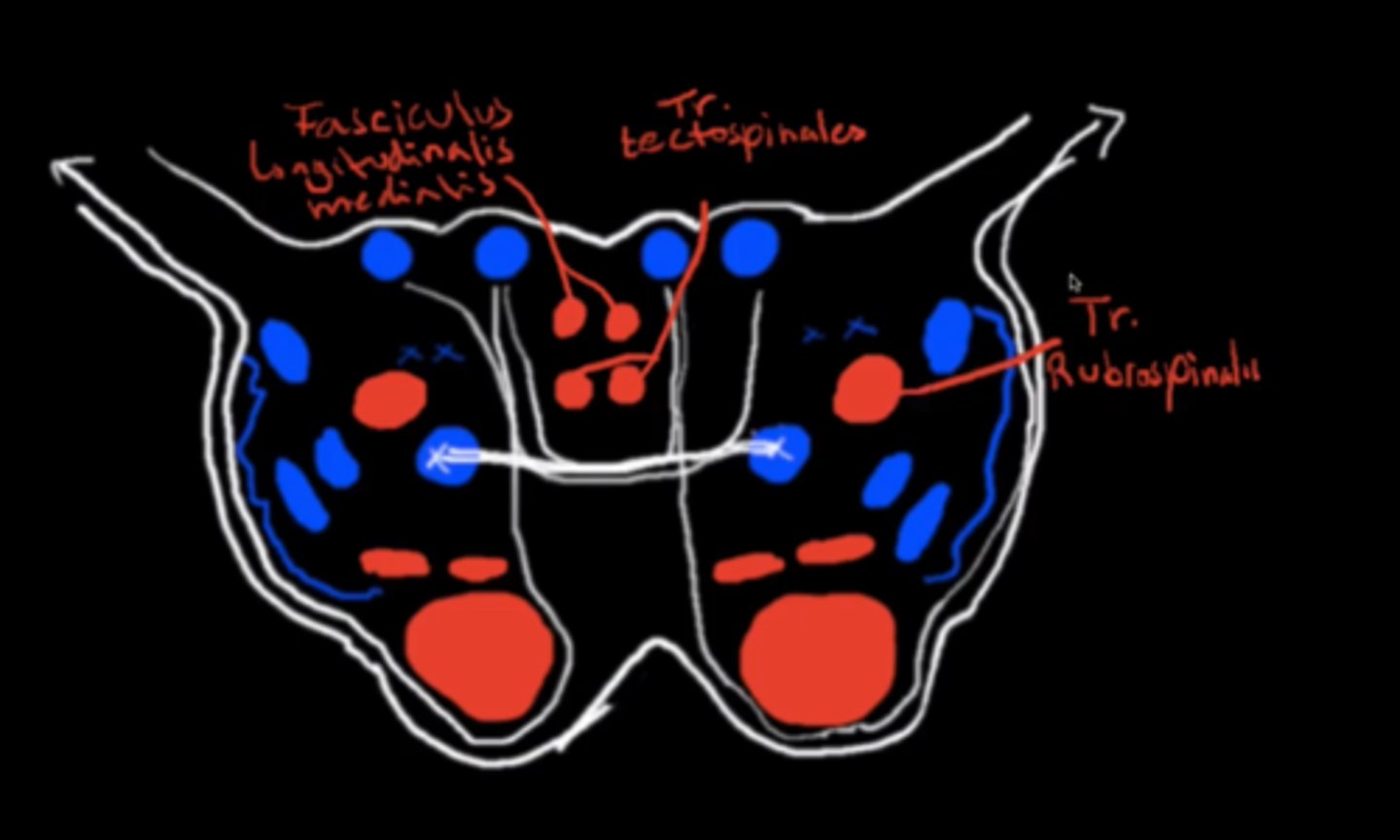Medulla oblongata
1/36
There's no tags or description
Looks like no tags are added yet.
Name | Mastery | Learn | Test | Matching | Spaced |
|---|
No study sessions yet.
37 Terms
medulla oblongata
lower part of brainstem
location: in skull on clivus
length: 2.5 cm
2 surfaces: ventral + dorsal
upwards:
- bound by pons
downwards:
- at level of foramen magnum
- continues into spinal cord
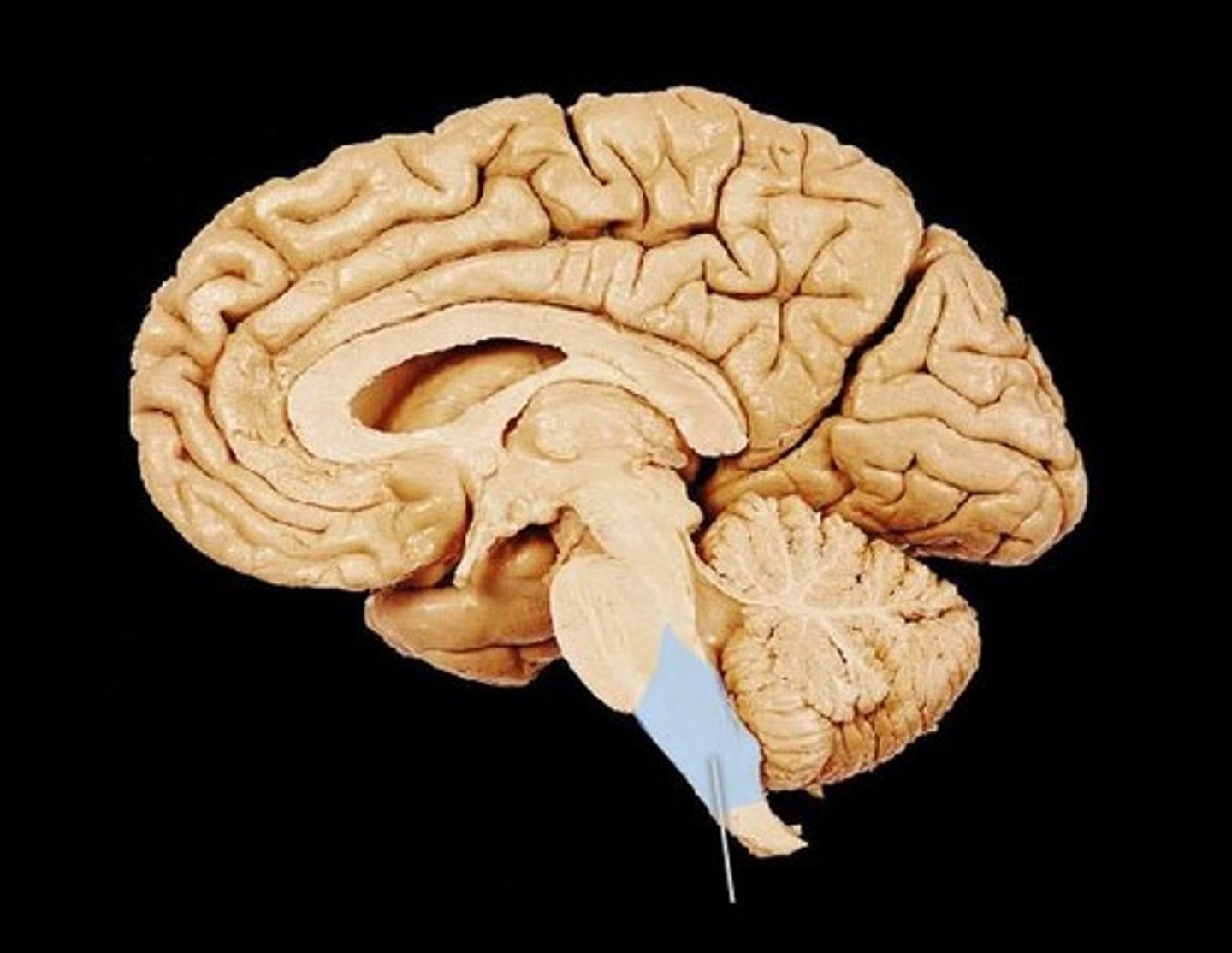
ventral surface
5 grooves:
- fissura mediana anterior
- sulcus anterolateralis dexter et sinister
- sulcus posterolateralis dexter et sinister
structures:
- pyramis medullae oblongatae
- decussatio pyramidum
- oliva
- n. hypoglossus (XII)
- n. accessorius (XI)
- n. vagus (X)
- n. glossopharyngeus (IX)
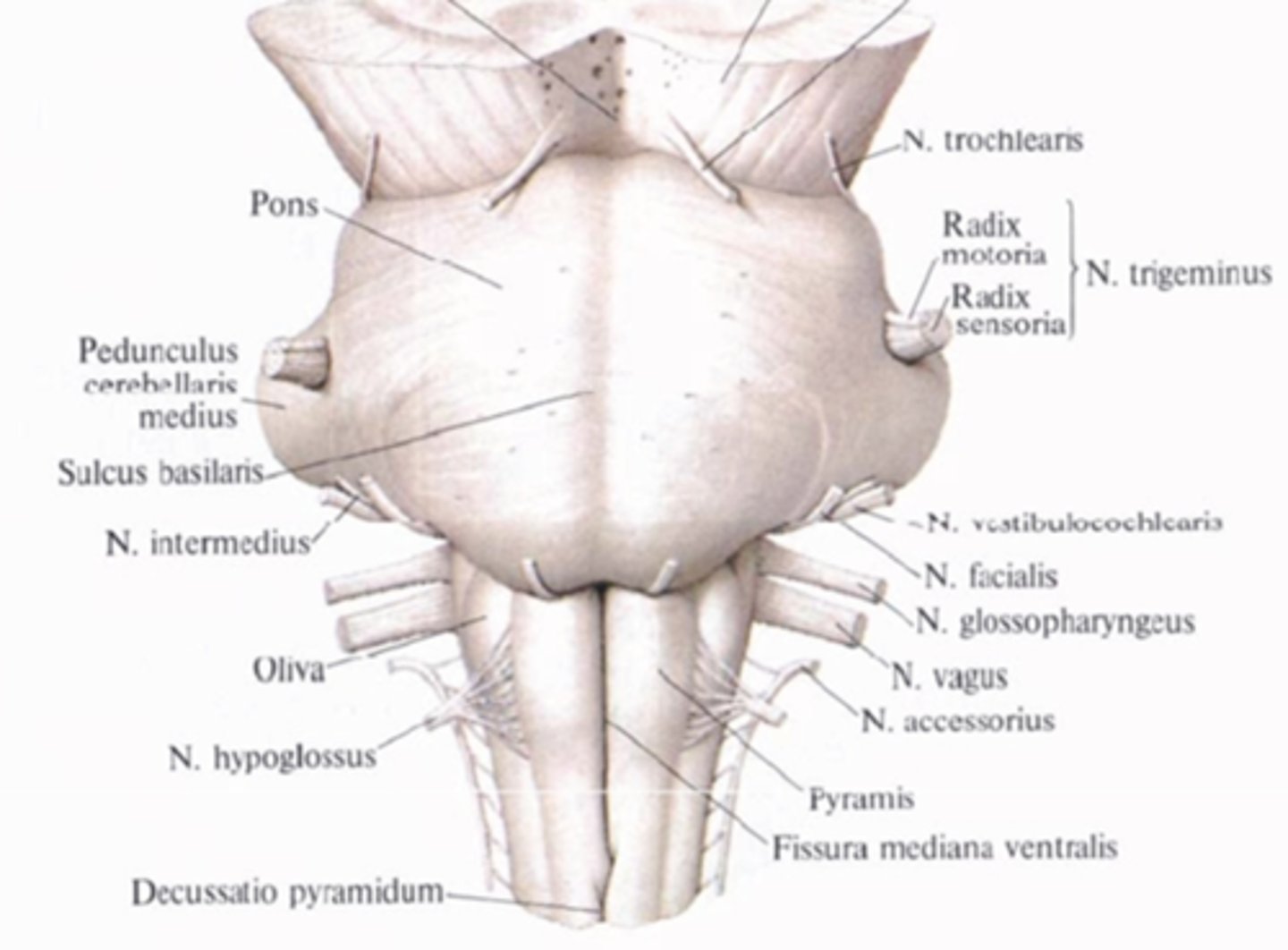
pyramis medullae oblongatae
location: on both sides of fissura mediana anterior
contains: tractus corticospinalis
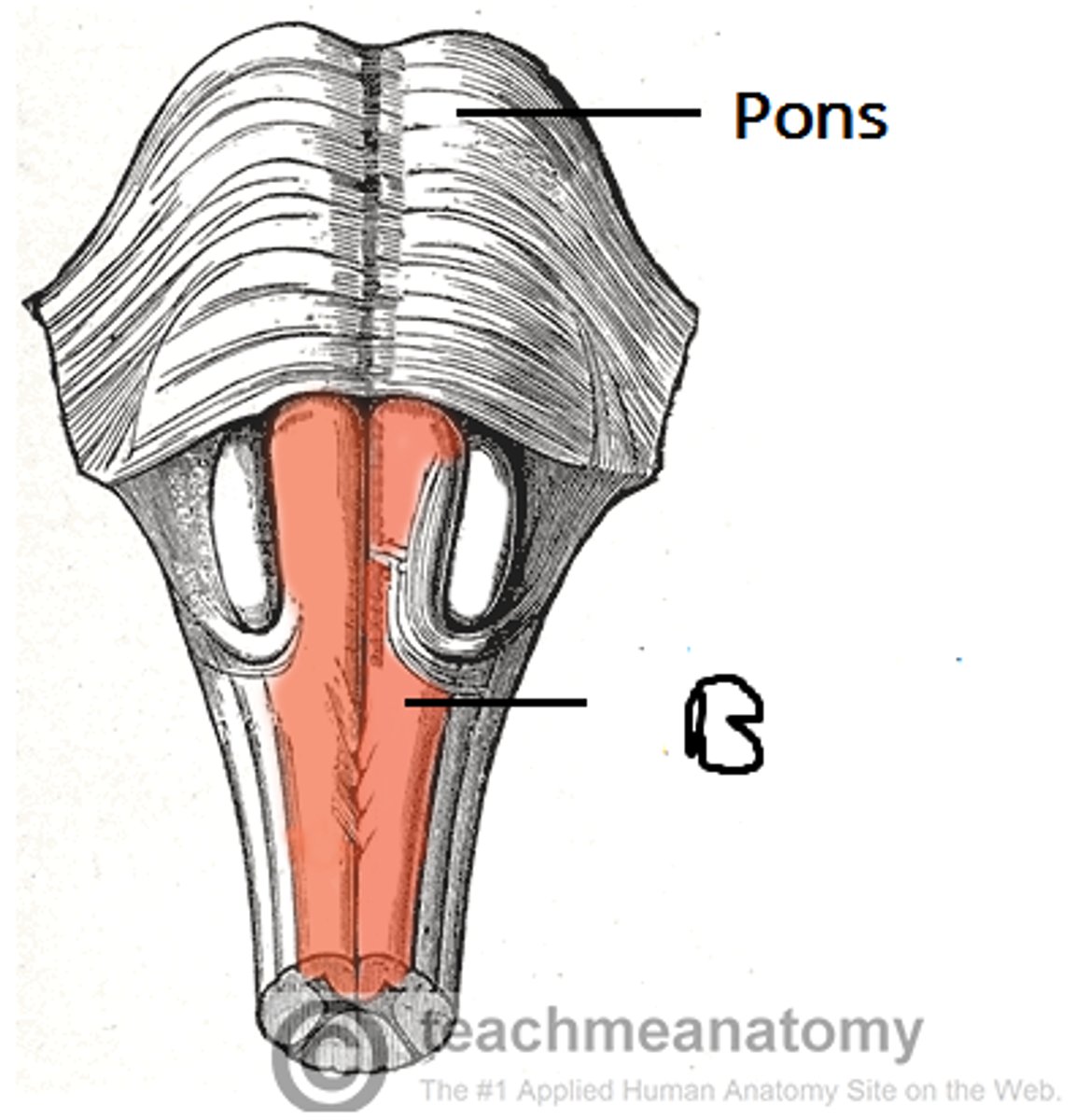
decussatio pyramidum
loaction: at lower end of pyramid
contains: crossed fibres of tractus corticospinalis
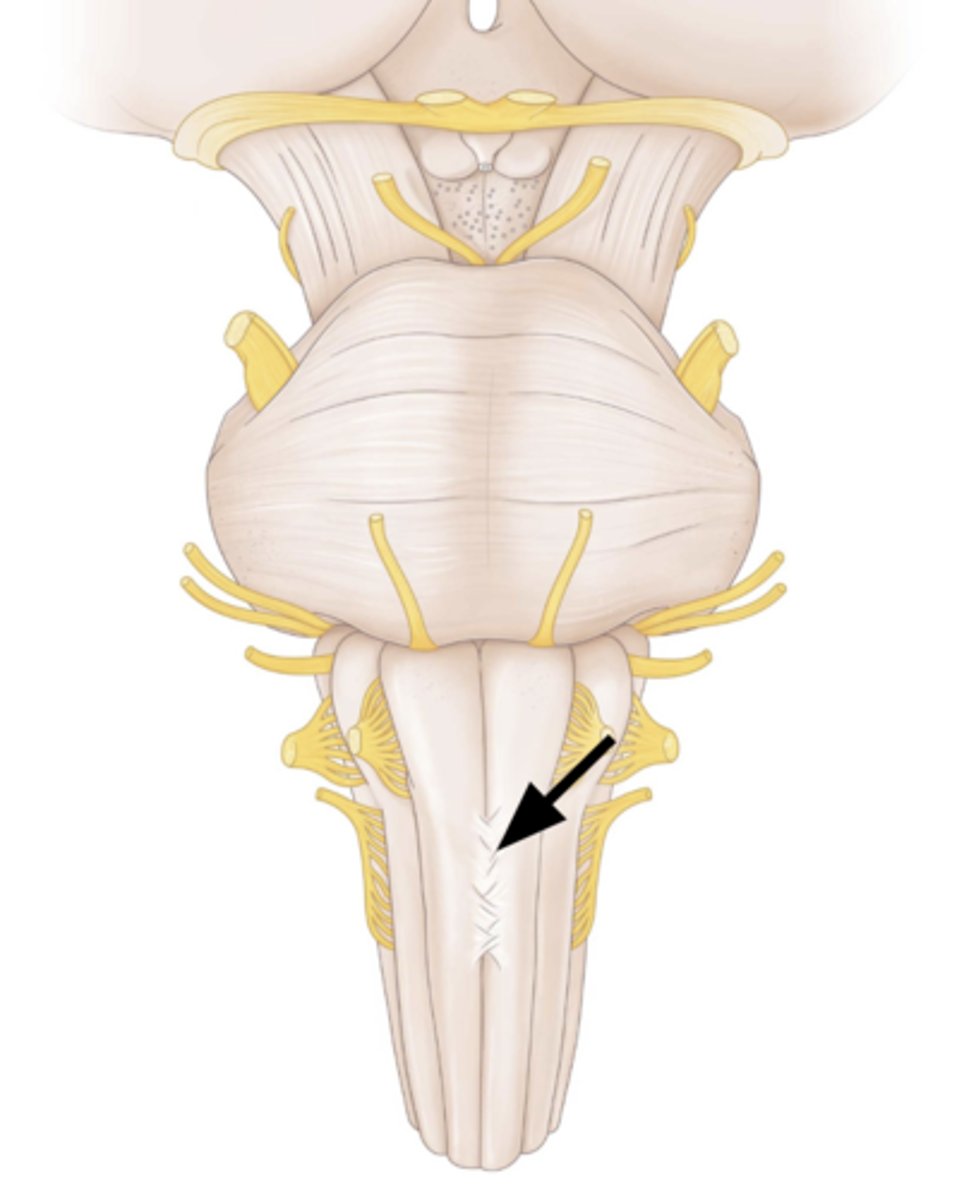
oliva
elevation
location: sulcus anterolateralis <--> sulcus posterolateralis
contains: nucleus olivaris

n. hypoglossus
XIIth cranial nerve
emerges: sulcus anterolateralis
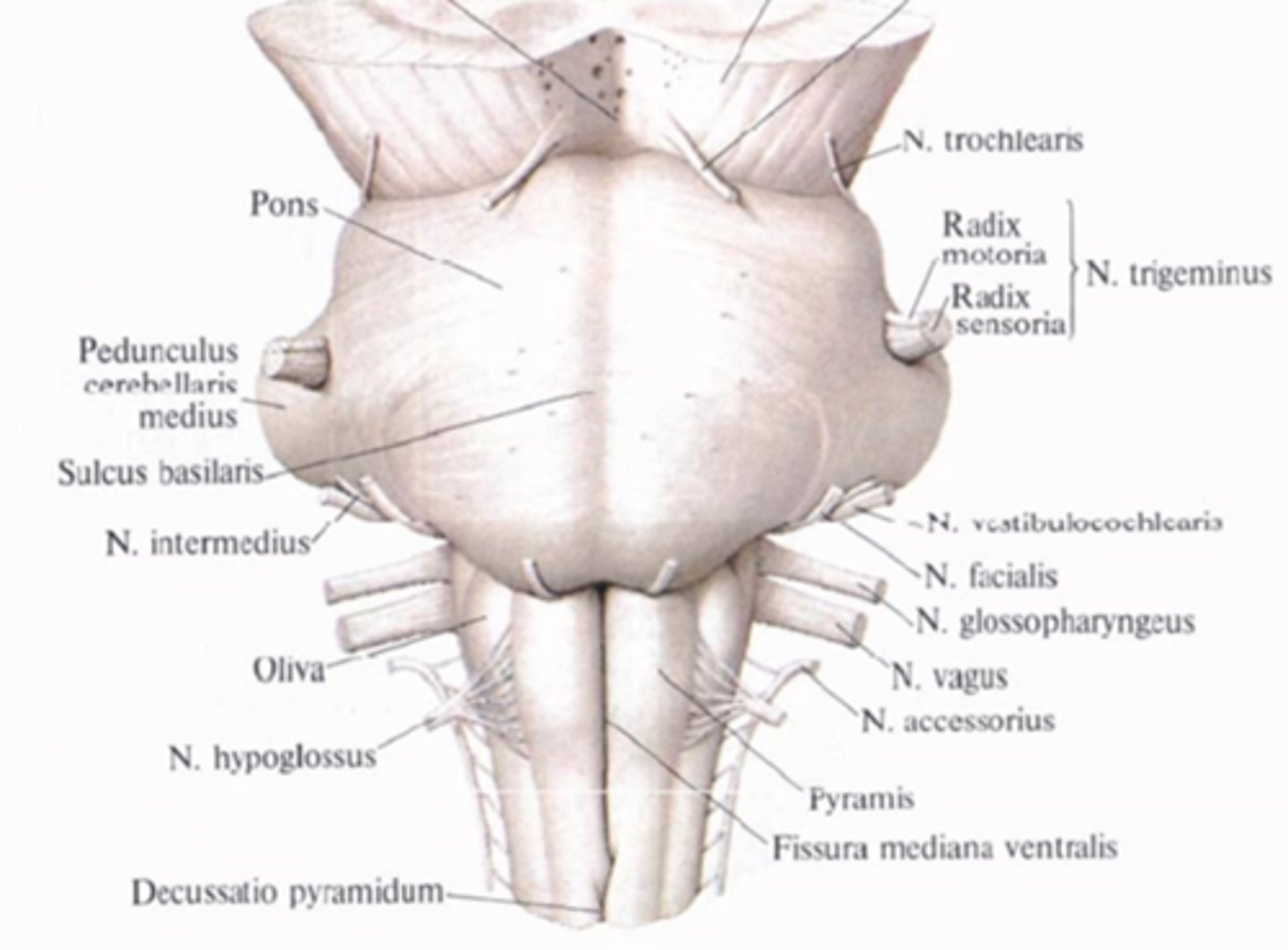
cranial nerves (vagus group)
emerge: in sulcus posterolateralis (next to oliva)
nervus glossopharyngeus (IX)
nervus vagus (X)
nervus accessorius (XI)
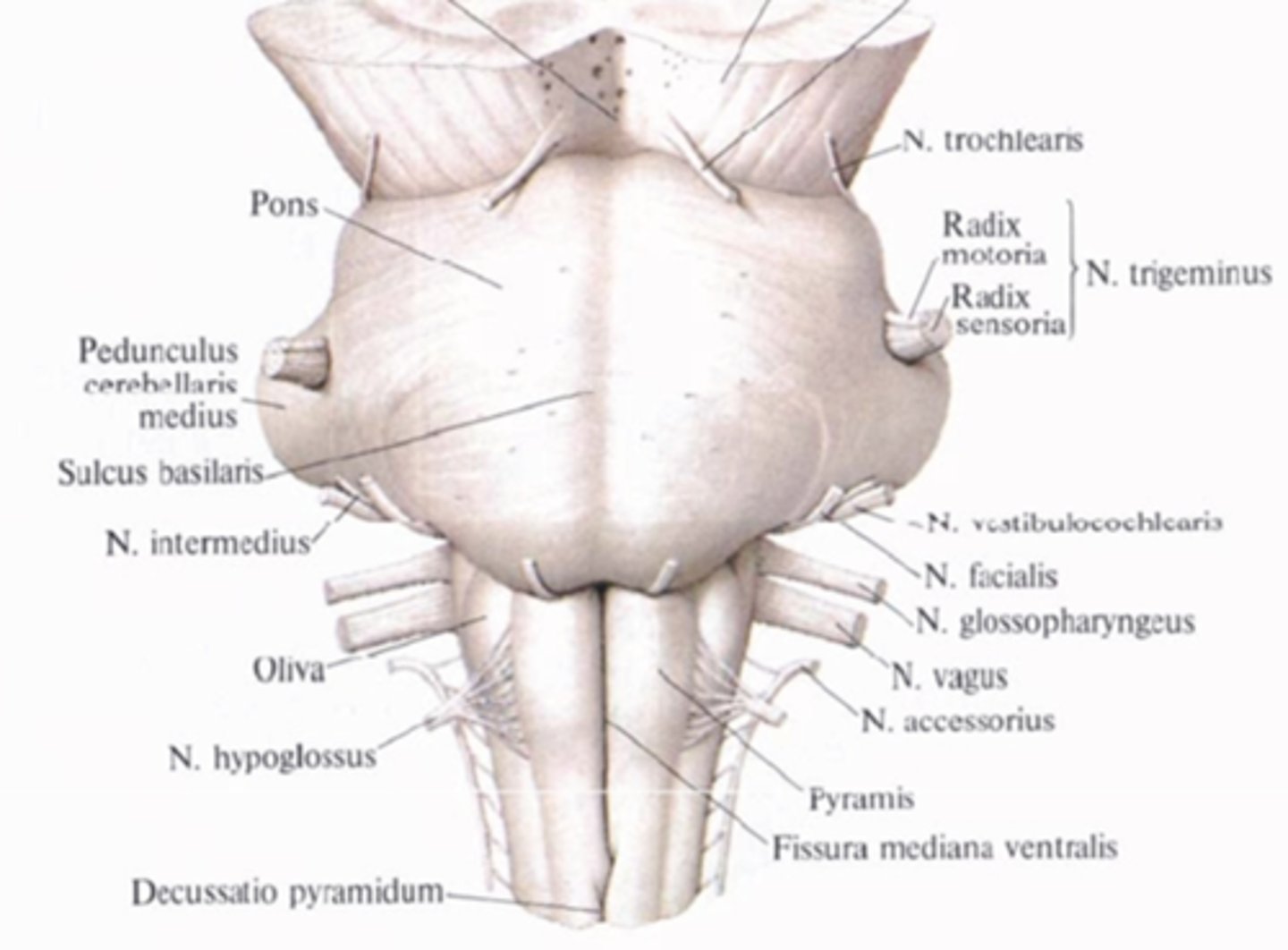
posterior surface
upper part:
- larger
- takes part in formation of fossa rhomboidea
laterally from upper part:
- pedunculus cerebellaris inferior
- to cerebellum
midline of lower part:
- sulcus medianus posterior
next to it:
- fasciuculus gracilis with tuberculum gracile
- where gray matter = nucleus gracilis
next to it:
- fasciculus cuneatus
- terminates with tuberculum cuneatum
- where gray matter = nucleus cuneatus
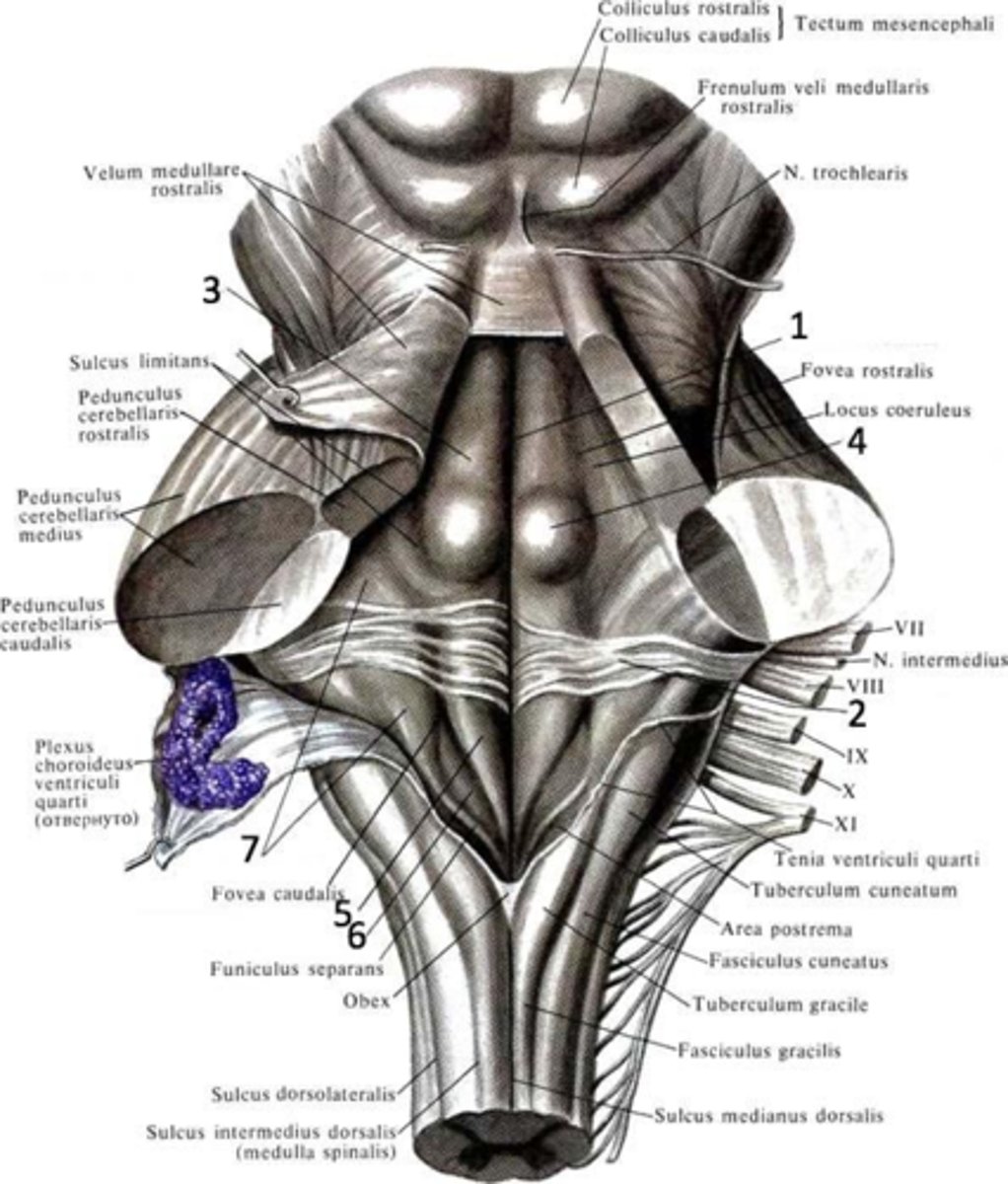
internal features of medulla oblongata
- substantia grisea
- substantia alba
medulla oblongata - substantia grisea
1. nuclei craniales
2. nucleus gracilis
3. nucleus cuneatus
4. nuclei olivares
5. formatio reticularis

medulla oblongata - substantia grisea - nuclei craniales
nuclei of cranial nerves VIII-XII
--> in fossa rhomboidea
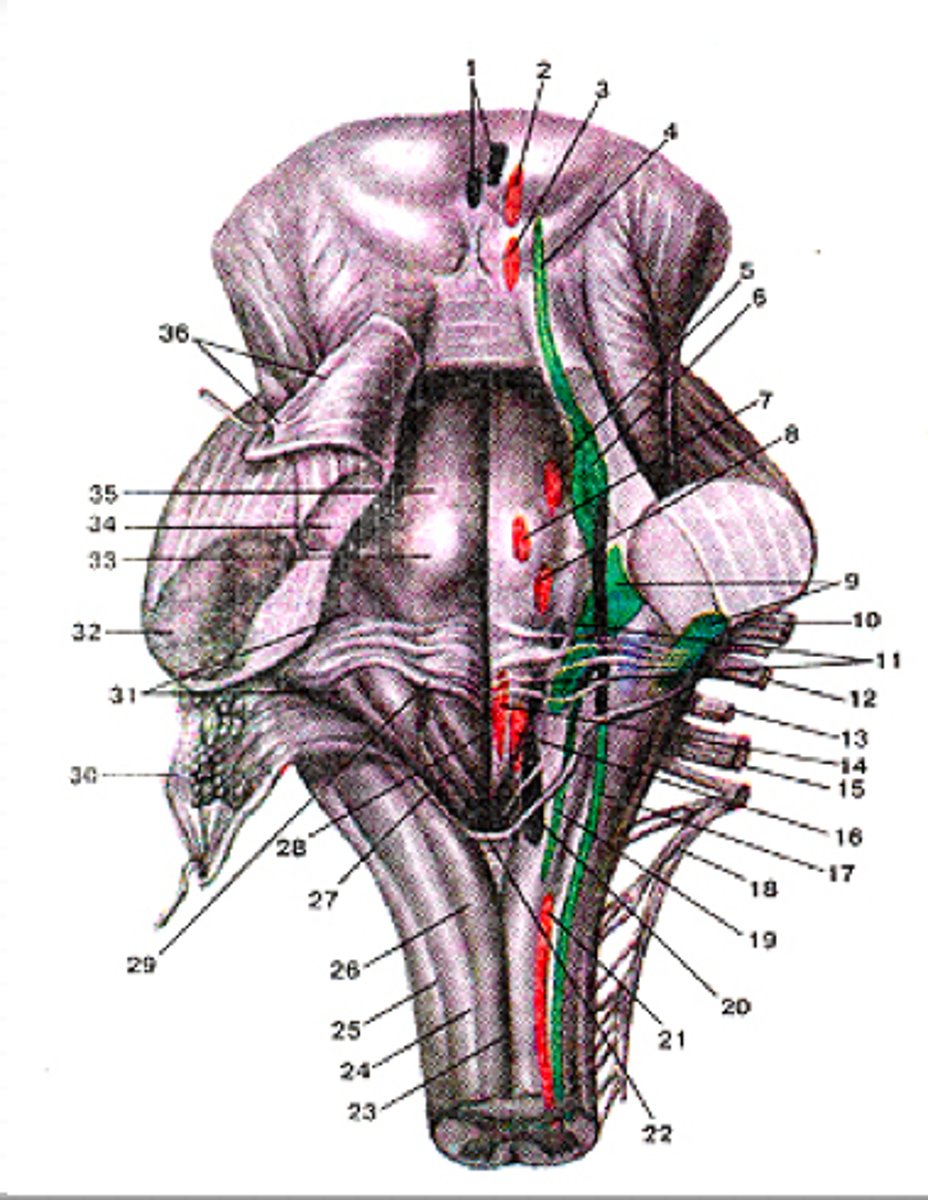
medulla oblongata - substantia grisea - nucleus gracilis
2nd neuron of epicritic sensibility pathway
--> in tuberculum gracile
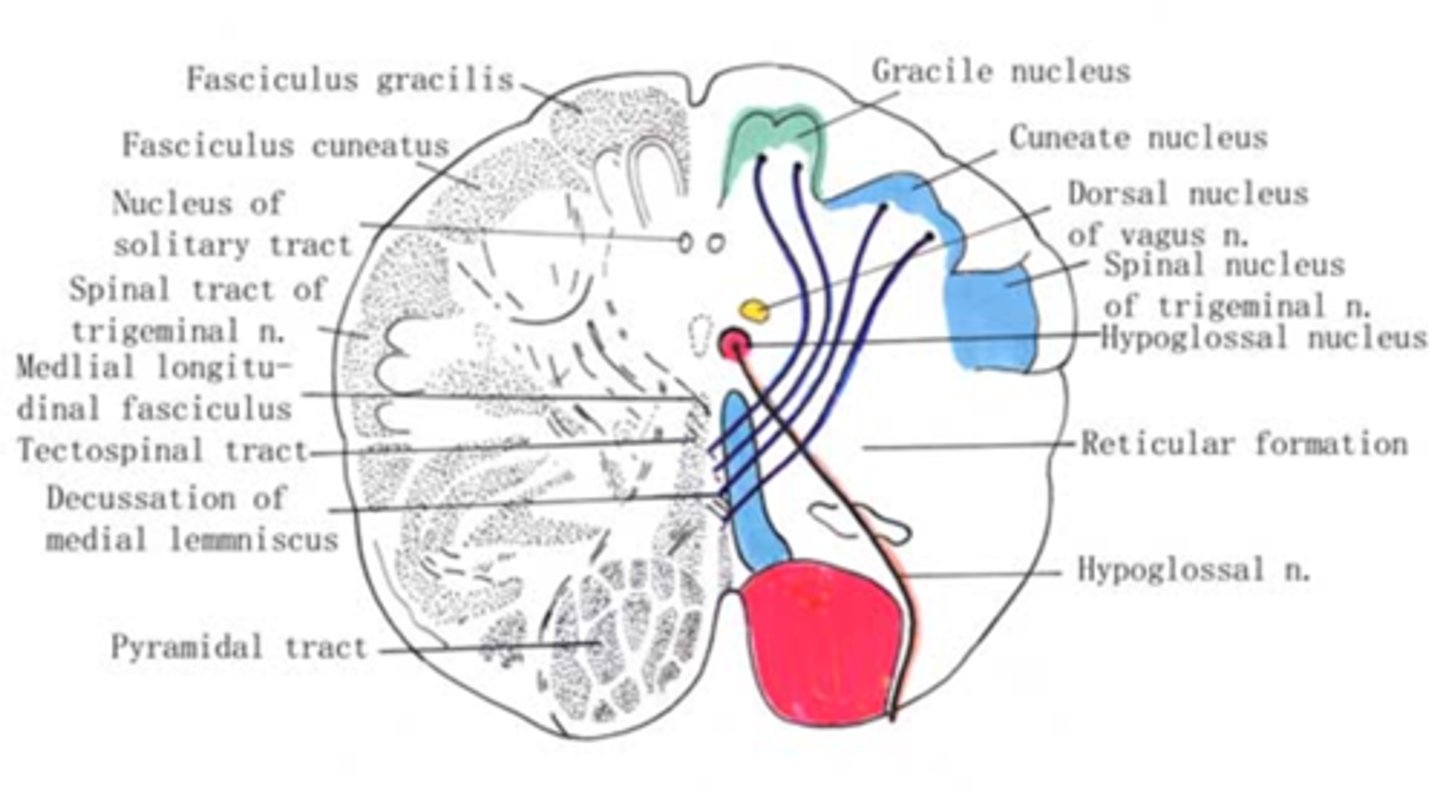
medulla oblongata - substantia grisea - nucleus cuneatus
2nd neuron of epicritic senibility pathway
--> in tuberculum cuneatum

medulla oblongata - substantia grisea - nuclei olivares
--> in oliva
start of:
- tractus olivospinalis
- tractus olivocerebellaris
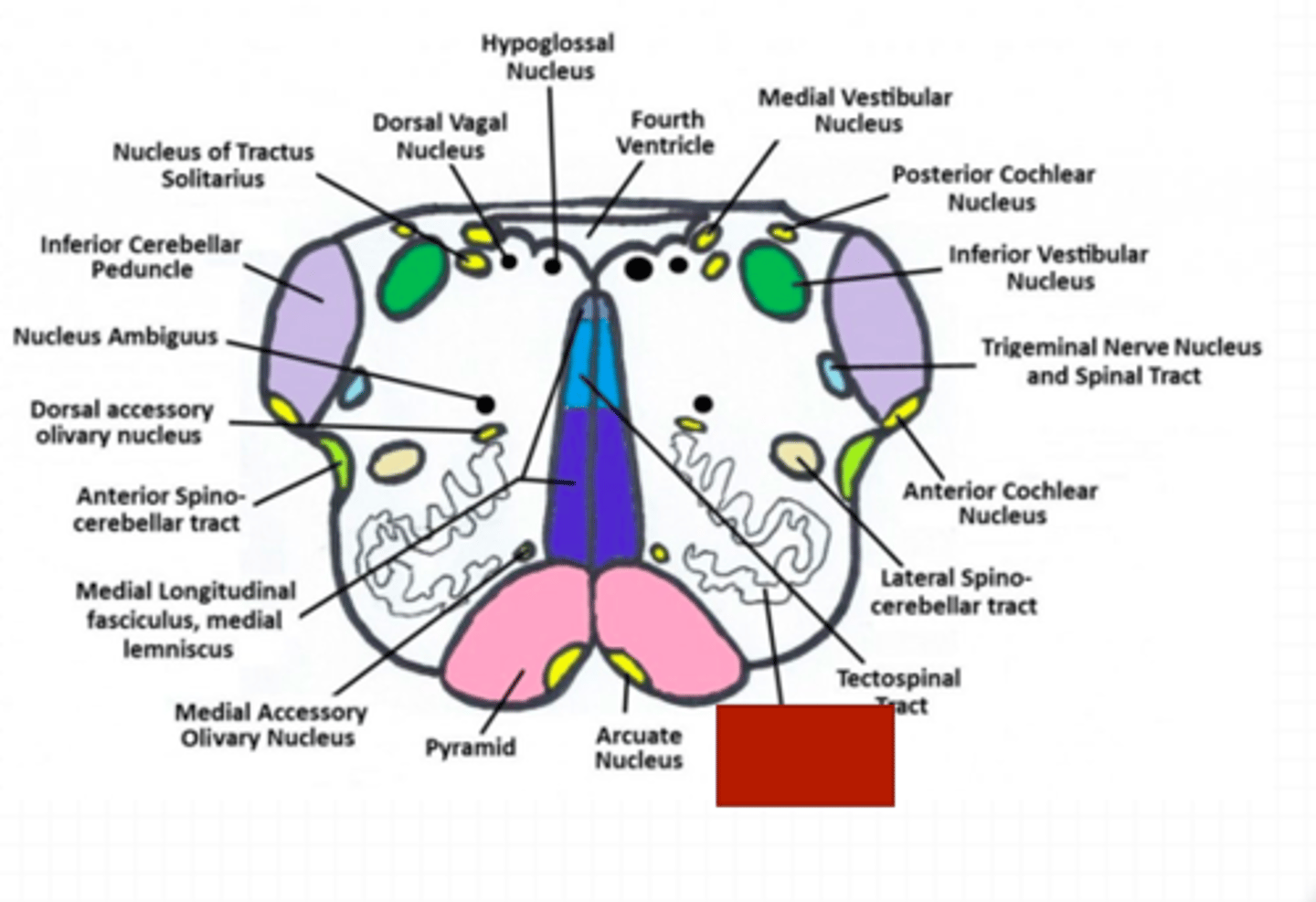
medulla oblongata - substantia grisea - formatio reticularis
diffuse network of cells + fibres
location:
- spinal cord + brainstem
- between pedunculi cerebellares inferiores
medial part: contains raphe nuclei
--> vast impact on CNS
connects to: cerebellum, thalamus, hypothalamus, cortex
function: influence on level of consciousness + other vital functions of body
(e.g. sleeping, walking, eating, urination, defecation, sexual activity)
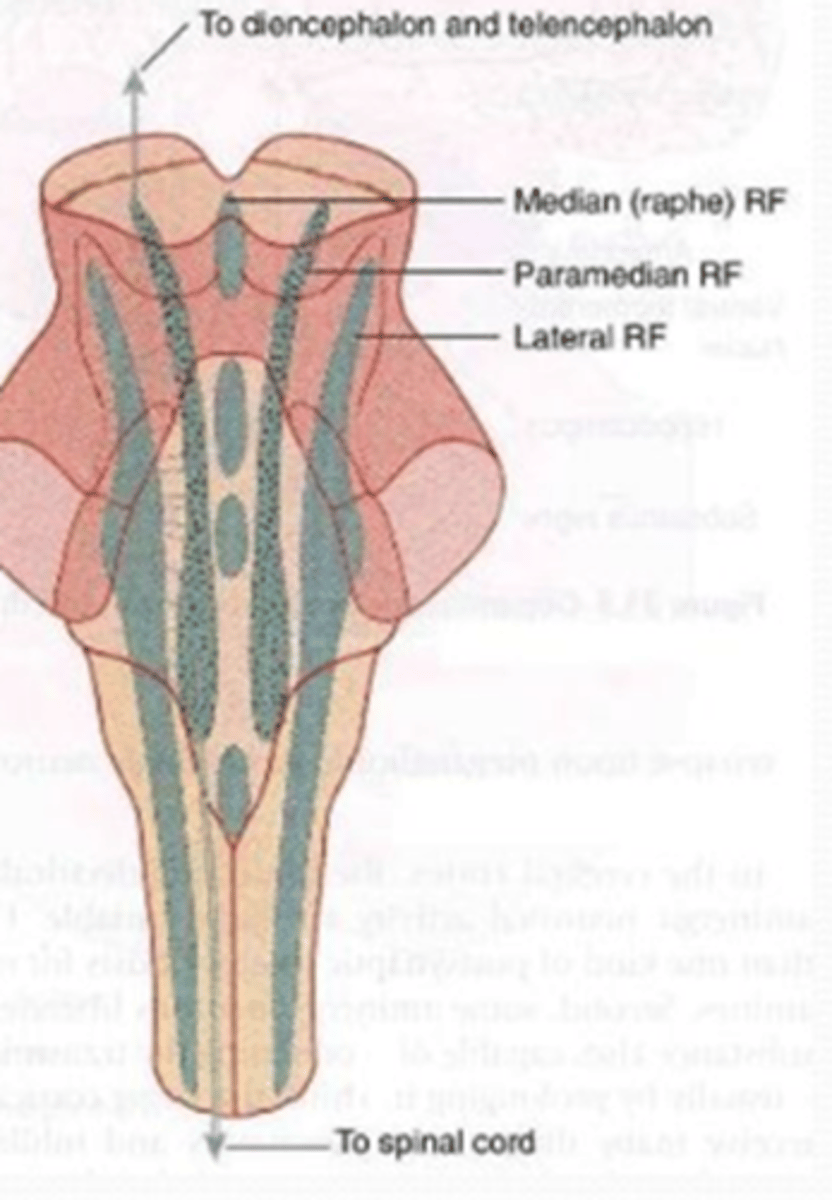
medulla oblongata - substantia alba
- tractus ascendentes
- tractus descendentes
medulla oblongata - substantia alba - tractus ascendentes
conscious (--> impulses to cortex)
- fasciculus gracilis
(fibrae arcuatae externae + internae)
- fasciculus cuneatus
(fibrae arcuatae externae + internae)
- tractus spinothalamicus lateralis
- tractus spinothalamicus anterior
unconscious (--> impluses to cerebellum)
- tractus spinocerebellaris posterior
- tractus spinocerebellaris anterior
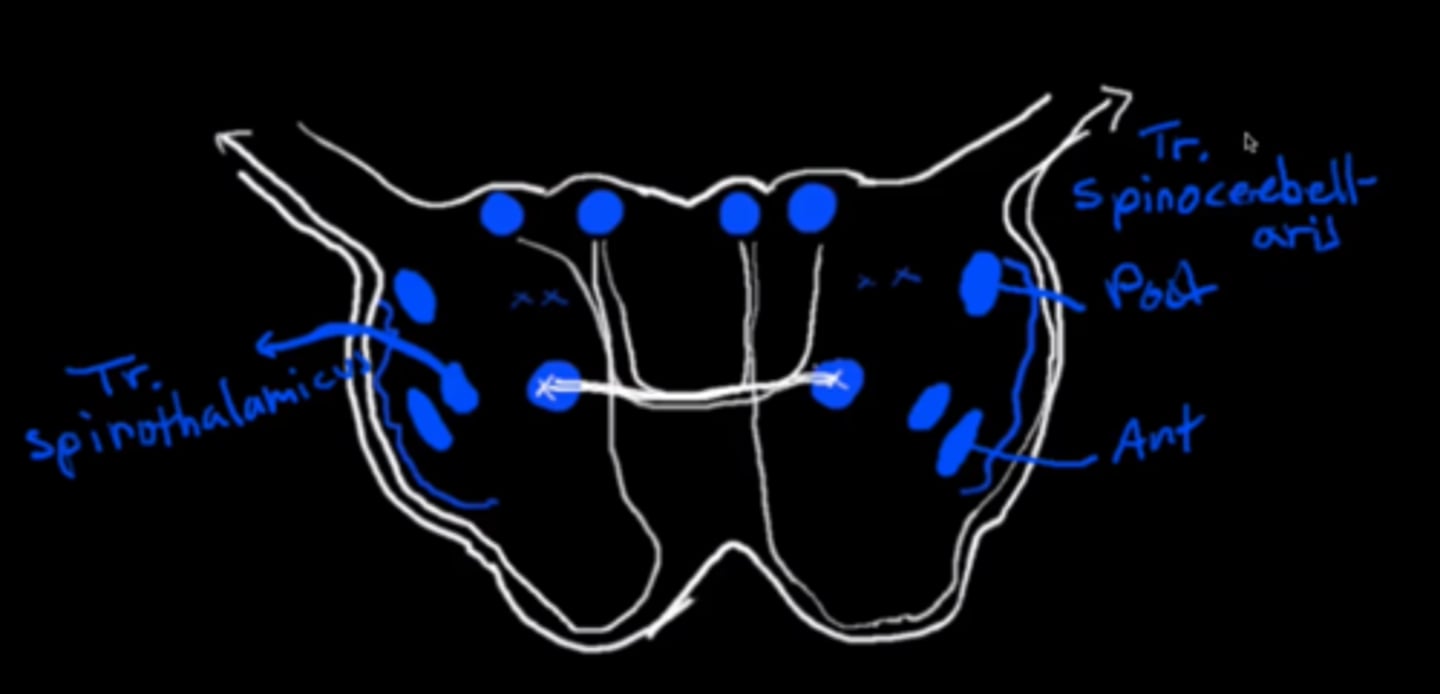
fasciculus gracilis and fasciculus cuneatus
substantia alba, tractus ascendentes
formed by: axons of pseudounipolar neurons of spinal ganglion
synapse with: 2nd neurons at nucleus gracilis or nucleus cuneatus
takes part in formation of: epicritic sensibility pathway
- info about position of body parts + their movements
axons form two groups of fibres:
a) fibrae arcuatae externae
- through pedunculi cerebellares inferiores --> cerebellum
b) fibrae arcuatae internae
- cross (decussatio lemnisci medialis --> ascends as lemniscus medialis)
fibrae arcuatae - picture
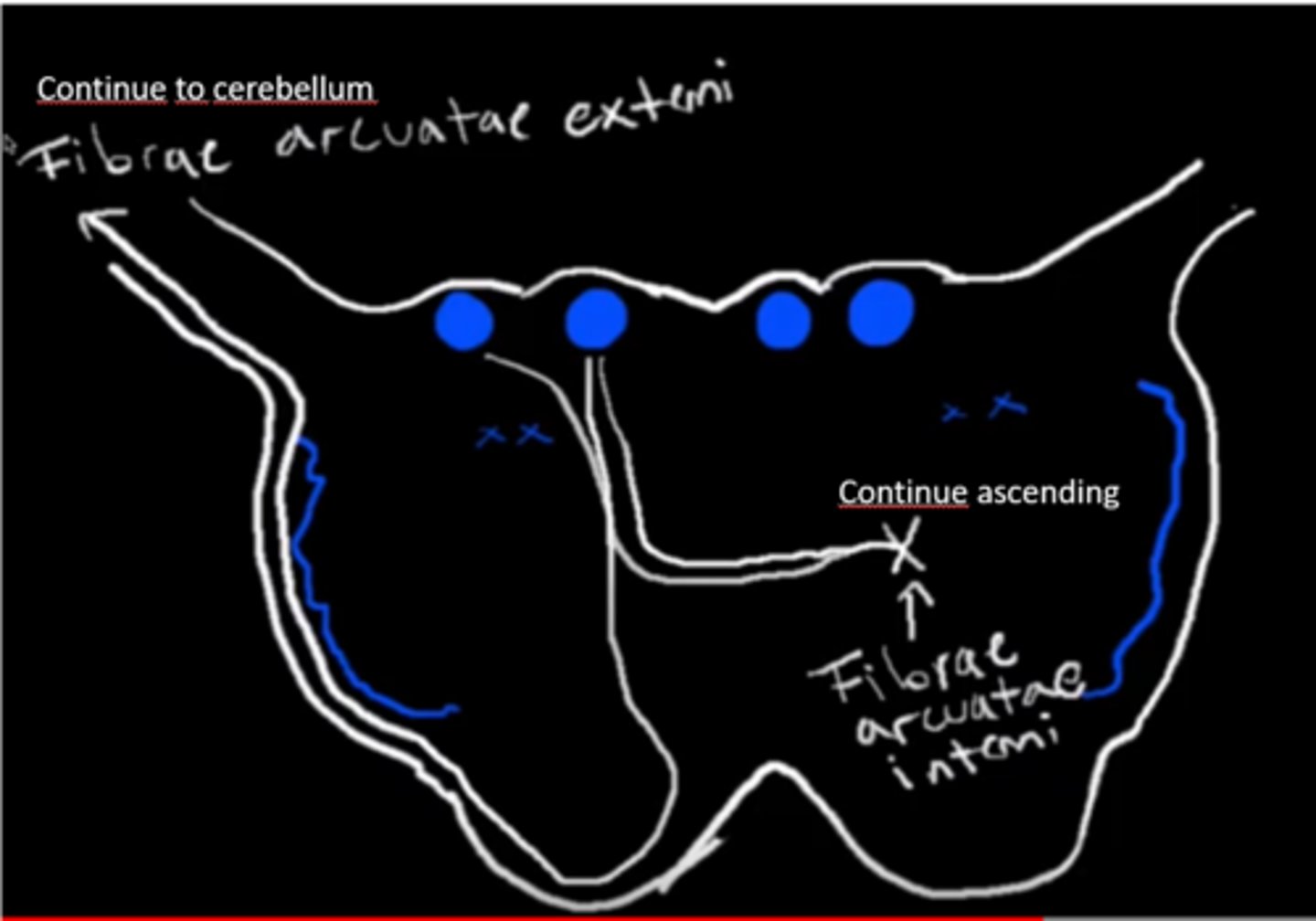
decussatio lemnisci medialis - picture
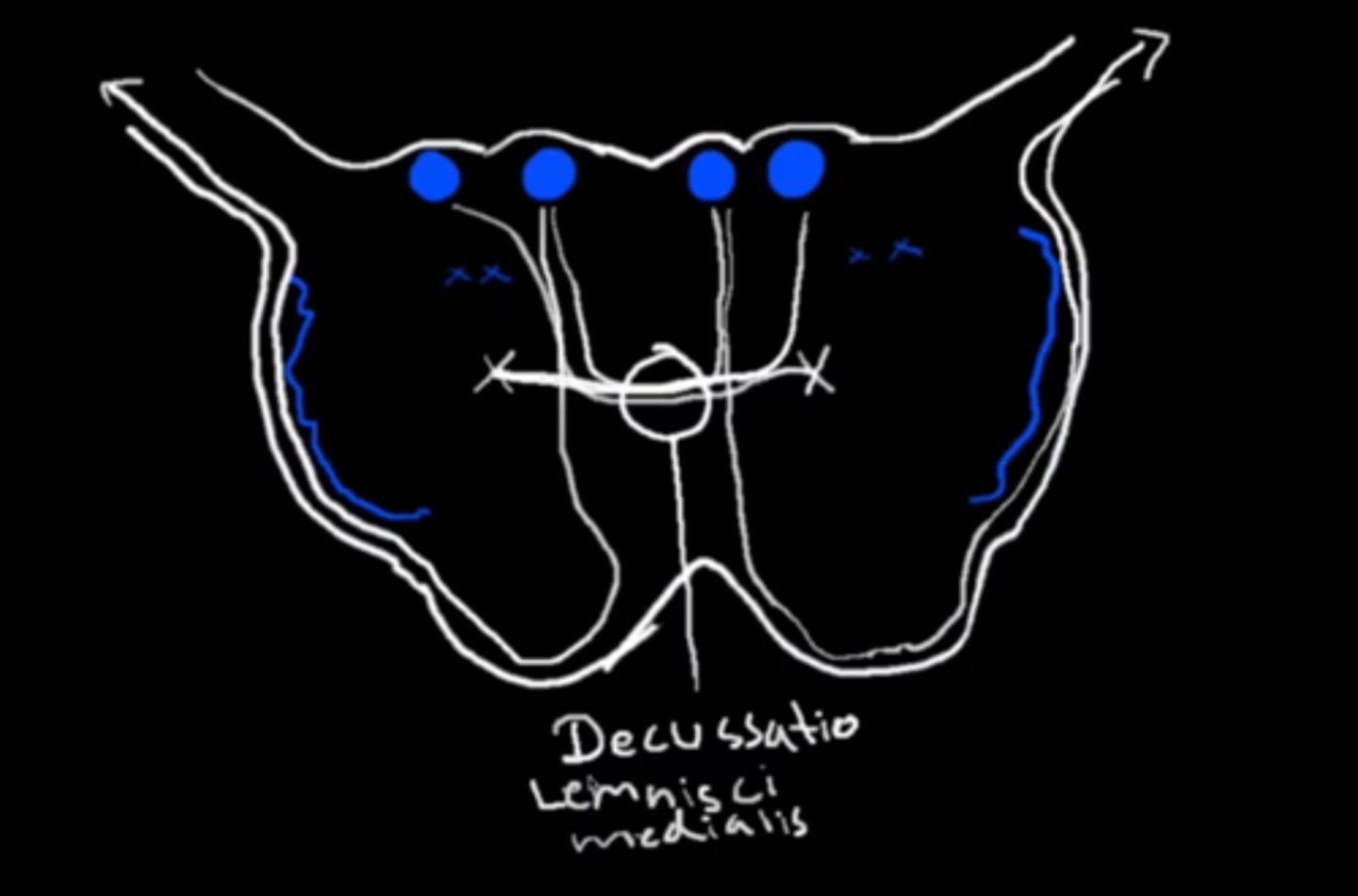
lemniscus medialis
ascends to: thalamus (diencephalon)
- to synapse with 3rd neurons
function: epicritic sensibility pathway

tractus spinothalamicus lateralis
substantia alba, tractus ascendentes
ascends to: thalamus (diencephalon)
- for synapsing
- as lemniscus spinalis
function: pain + temperature pathway
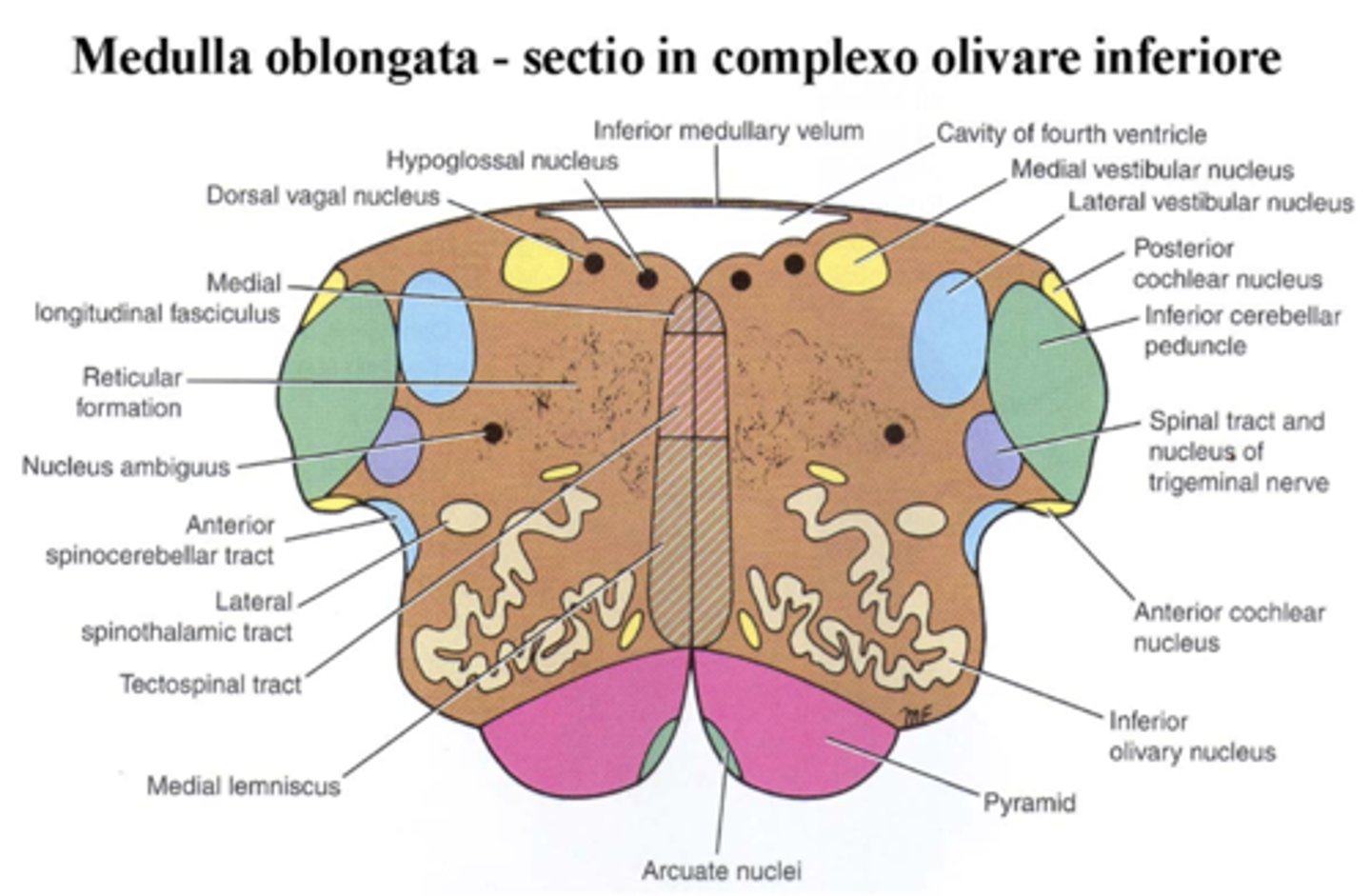
tractus spinothalamicus anterior
substantia alba, tractus ascendentes
ascends to: thalamus (diencephalon)
- for synapsing
- as lemniscus spinalis
function: touch pathway
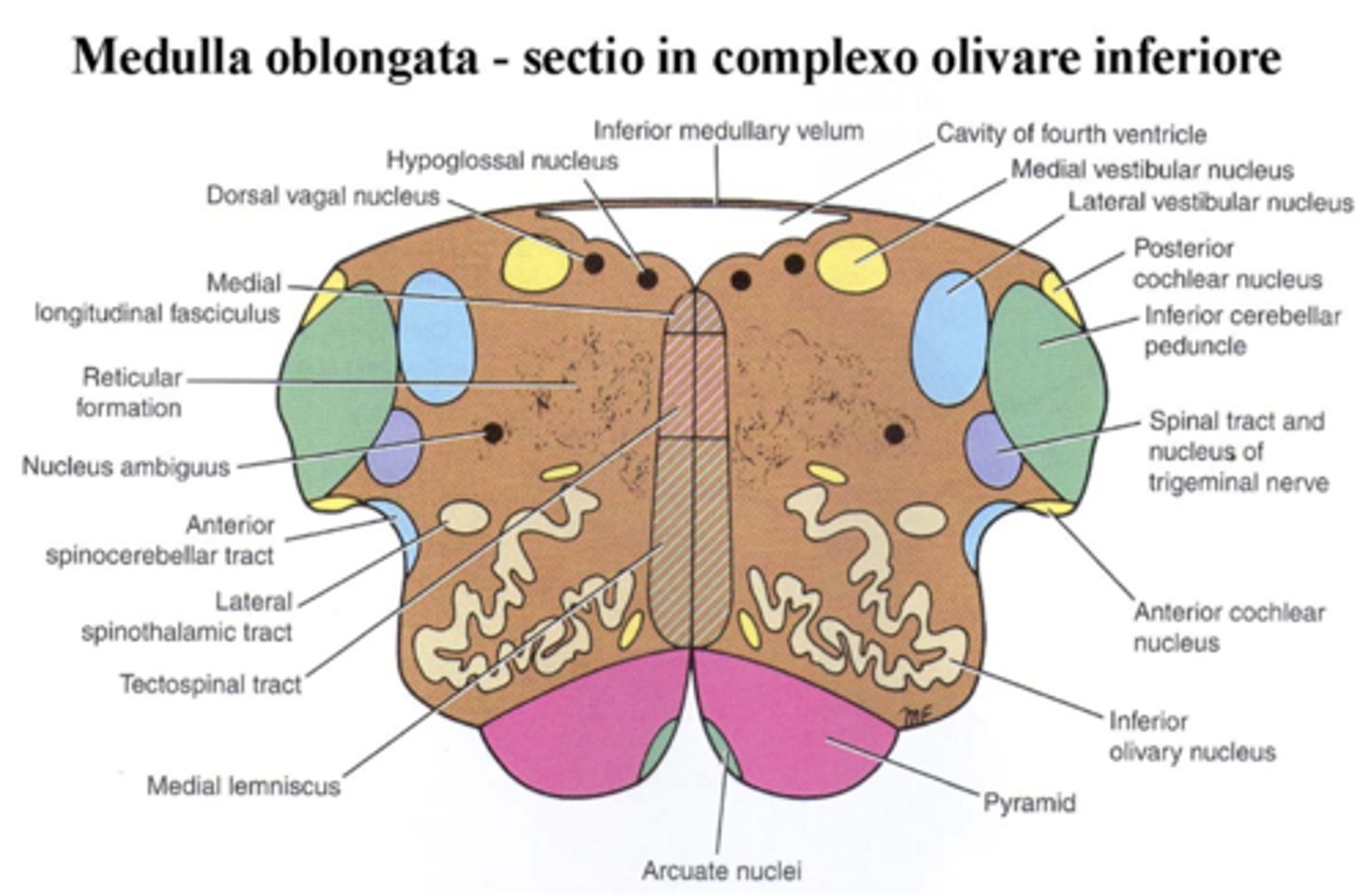
lemniscus spinalis - picture
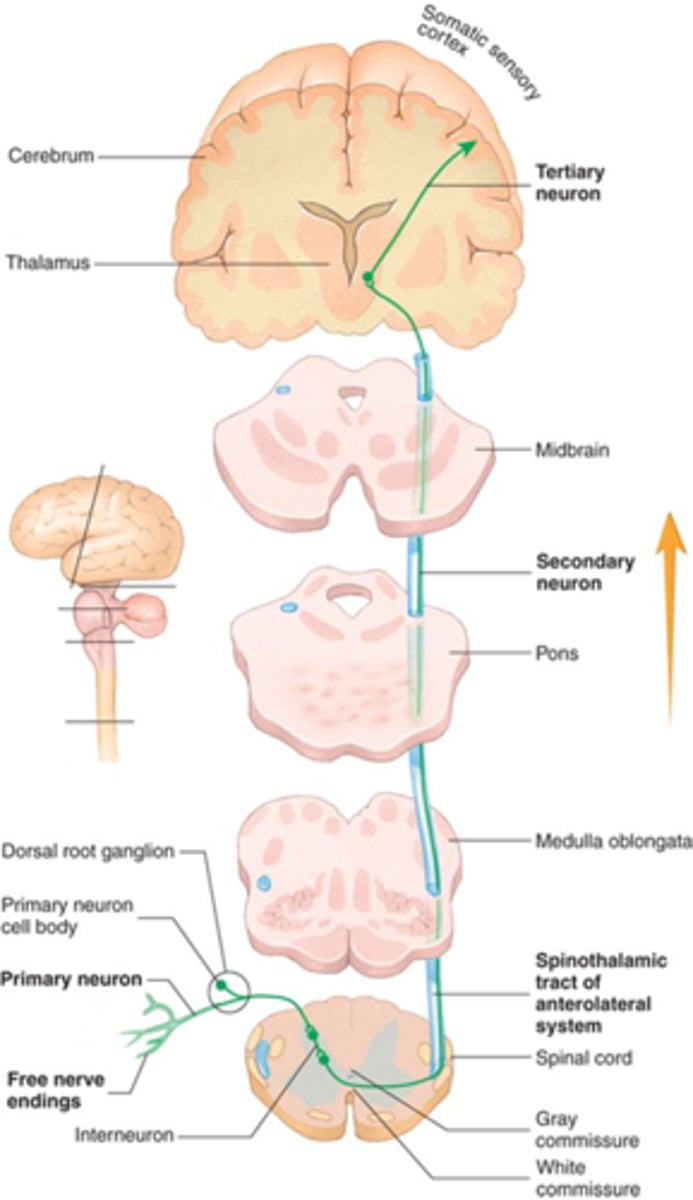
tractus spinocerebellaris posterior
substantia alba, tractus ascendentes
ascends to: cerebellum
- via pendunculus cerebellaris inferior
function: unconscious proprioreceptive / deep sensation pathway
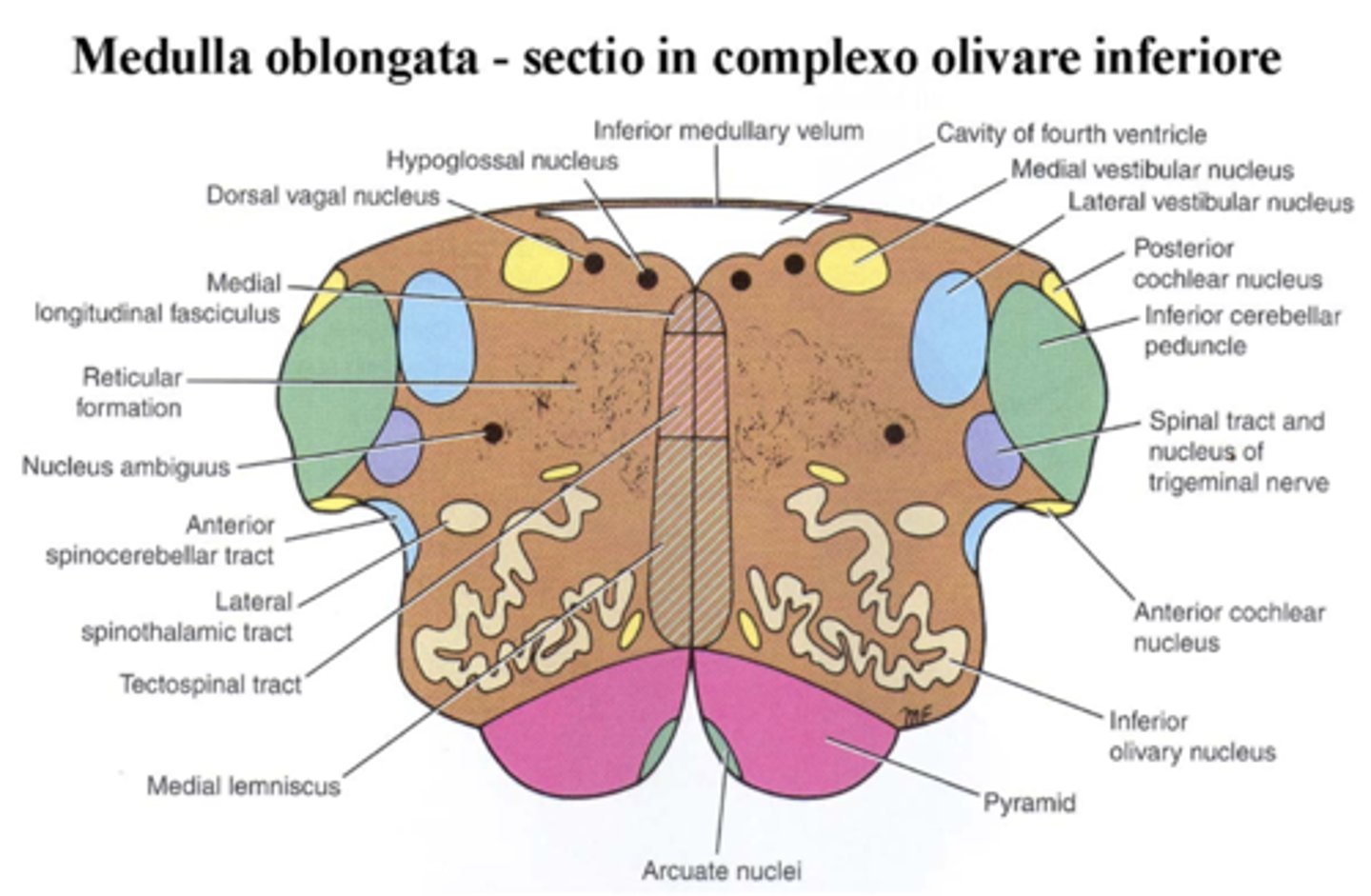
tractus spinocerebellaris anterior
substantia alba, tractus ascendentes
ascends to: cerebellum
- passes through pons and mesencephalon
- via pendunculus cerebellaris superior
function: unconscious proprioreception / deep sensation pathway
tractus spinothalamicus, tractus spinocerebellaris - picture
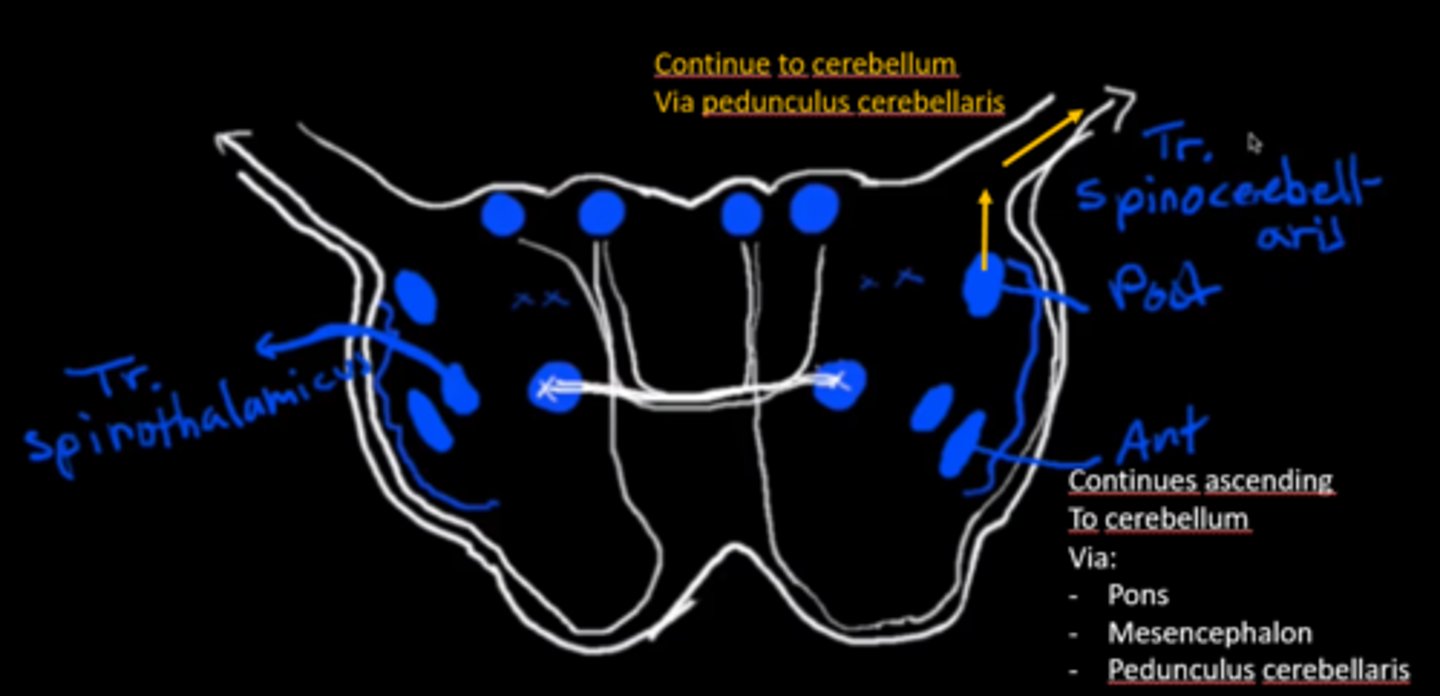
medulla oblongata - tractus descendentes
pyramidal system (for voluntary movements)
- tractus corticospinalis
- tractus corticonuclearis
extrapyramidal system (for unvoluntary movements)
- tractus vestibulospinalis
- tractus vestibulocerebellaris
- tractus olivospinalis
- tractus olivocerebellaris
- tractus rubrospinalis
- tractus tectospinalis
- fasciculus longitudinalis medialis
- tractus reticulospinalis
tractus corticospinalis
substantia alba, tractus descendentes
formed by: axons of pyramidal cells of cortex
- belongs to pyramidal system
descend to: motor nuclei (spinal cord)
- passes through pyramis
function: for voluntary control of skeletal muscles for the trunk + limbs
majority of fibres 80%:
crossed (decussatio pyramidum)
20% of fibres:
uncrossed
--> continue in anterior funiculus (spinal cord)
--> as tractus corticospinalis anterior
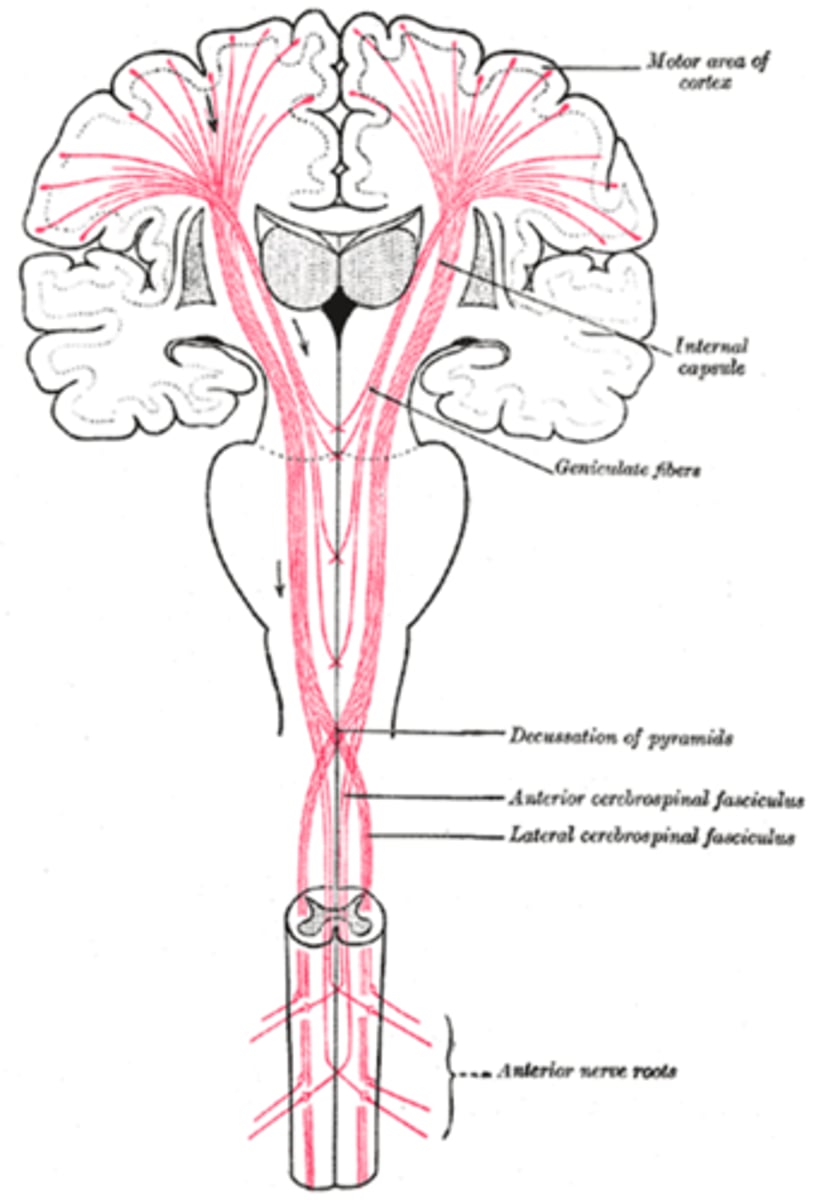
tractus corticonuclearis
substantia alba, tractus descendentes
formed by: axons of pyramidal cells of cortex
- belongs to pyramidal system
synapses with: motor nuclei of cranial nerves (IX, X, XI, XII)
function: for voluntary control of skeletal muscles of head + neck
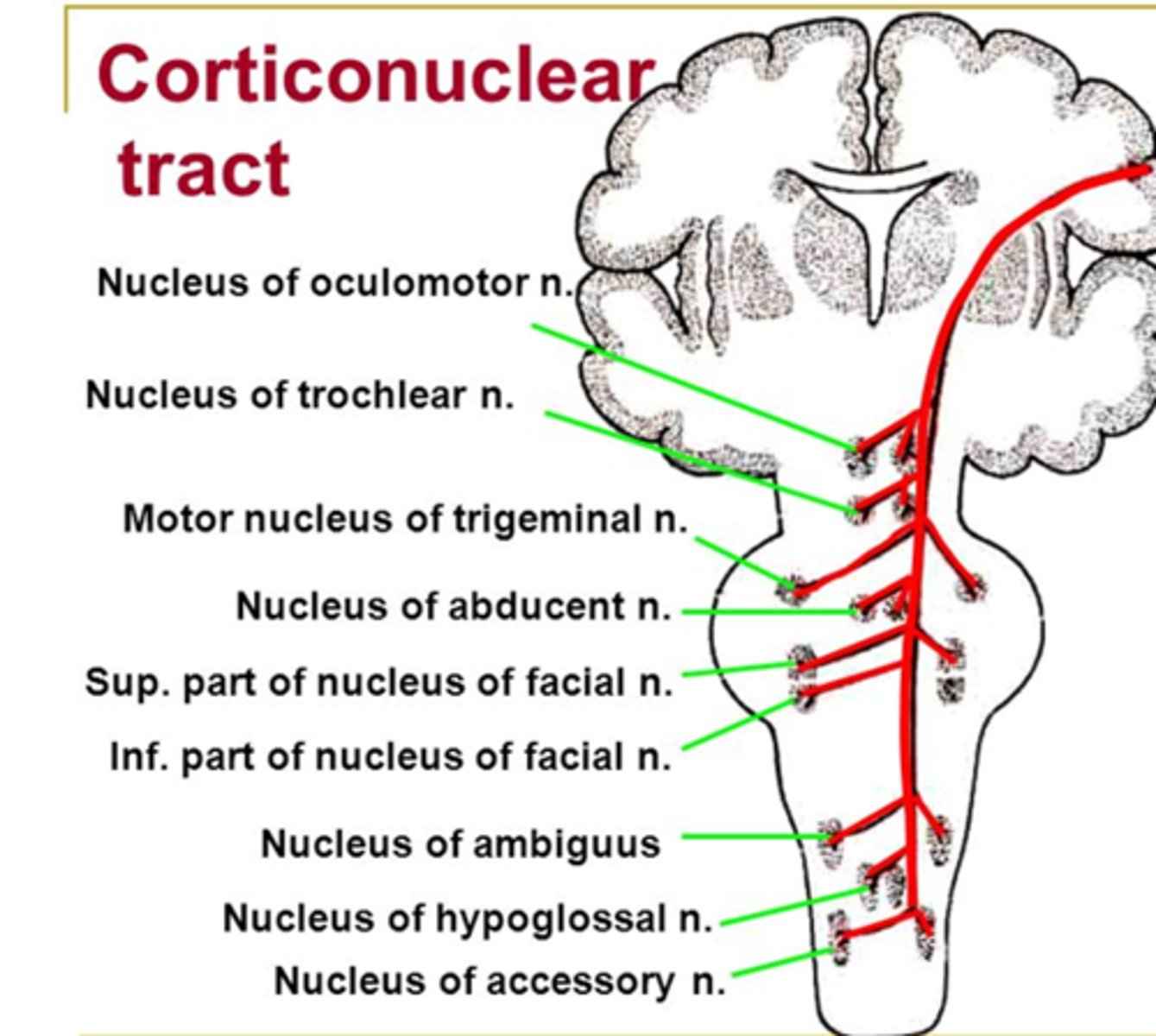
tractus corticospinalis, tractus corticonuclearis - picture
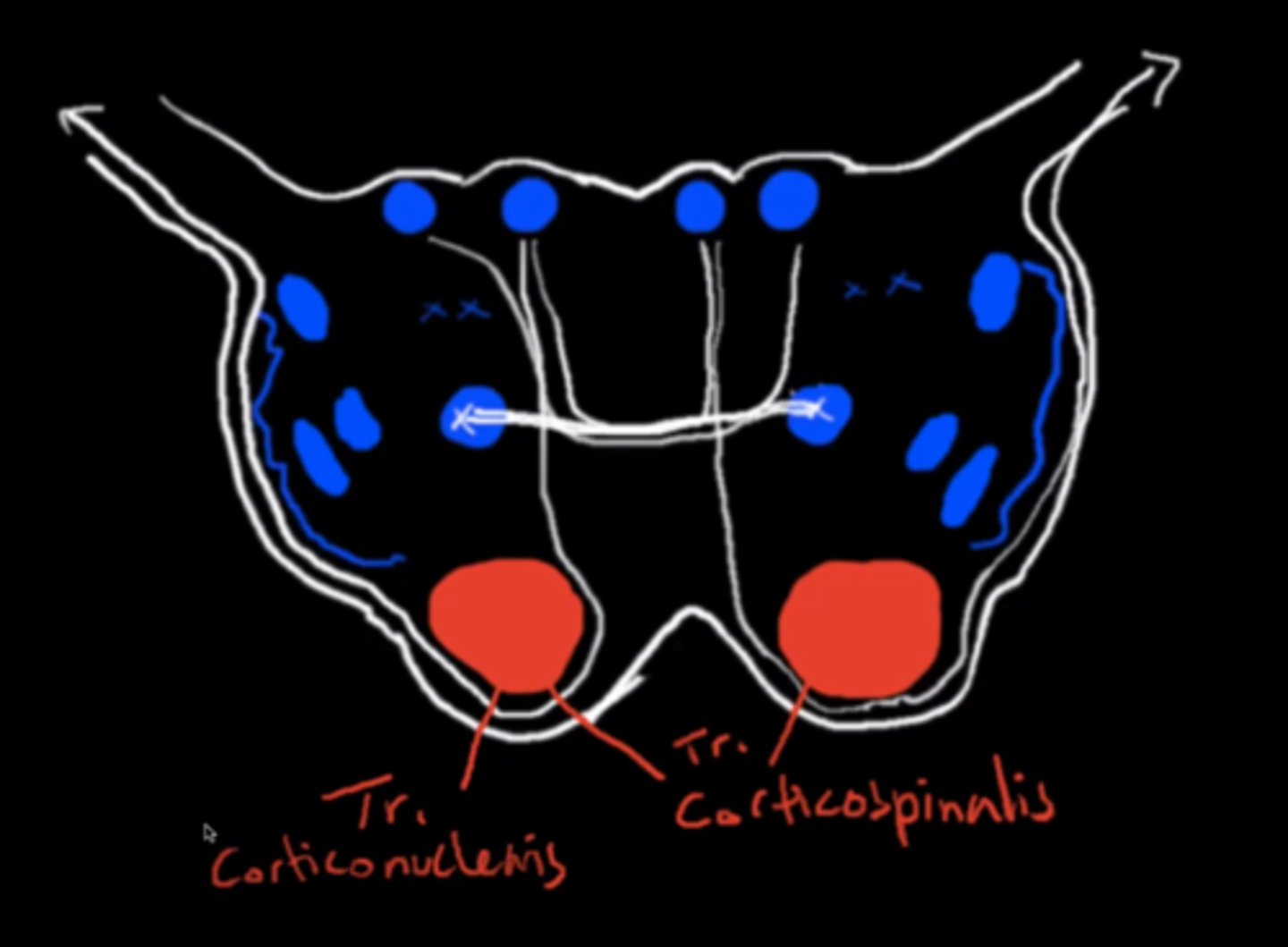
tractus vestibulospinalis
substantia alba, tractus descendentes
formed by: axons of nuclei vestibulares (fossa rhomboidea)
descends to: motor nuclei cornu anterioris (spinal cord)
function: balance pathway
- coordination of unvoluntary movements concerned with balance + posture
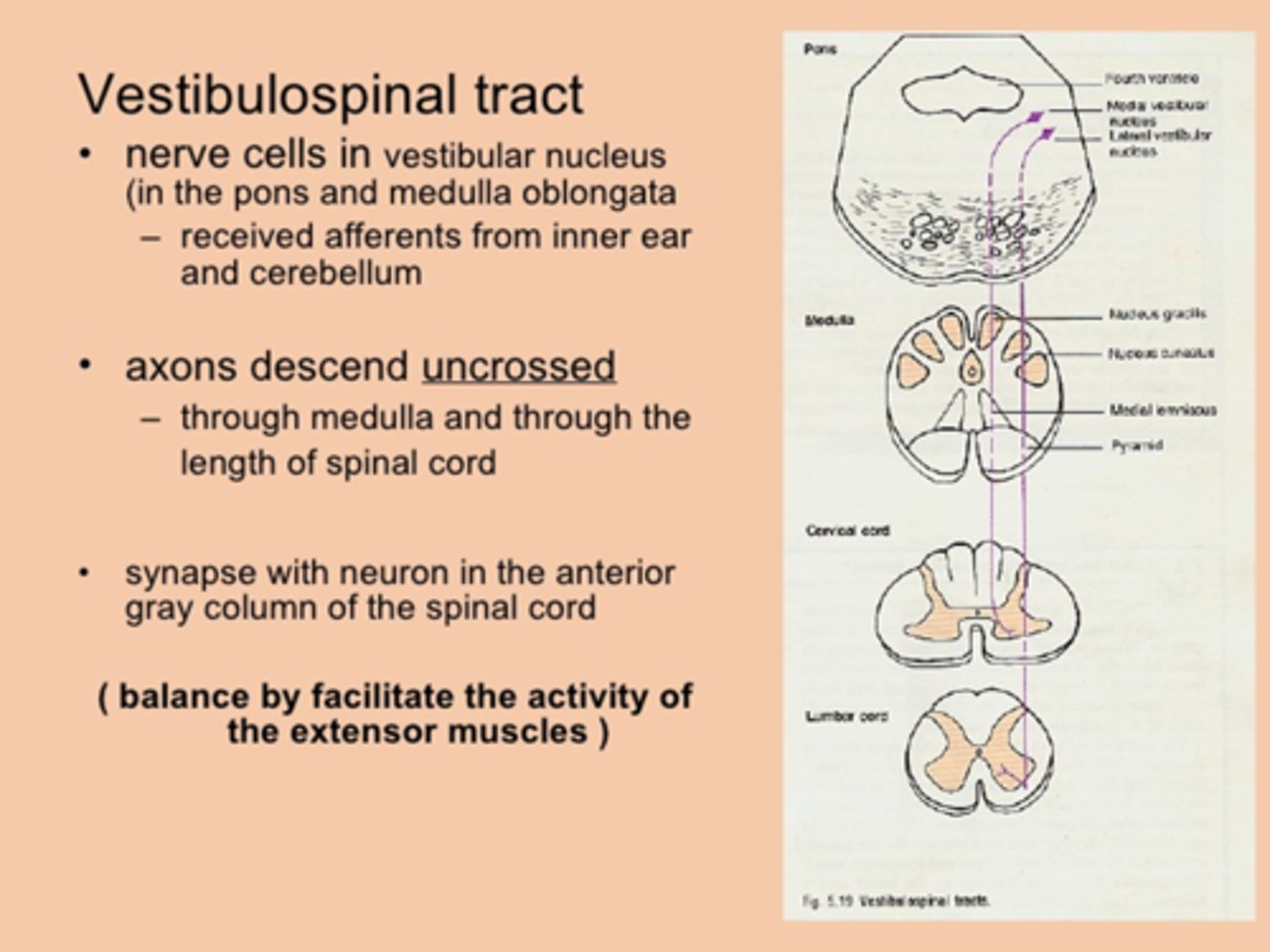
tractus vestibulocerebellaris
substantia alba, tractus descendentes
formed by: axons of nuclei vestibulares (fossa rhomboidea)
descends to: gray matter of cerebellum
function: takes part in balance pathway
- coordination of unvoluntary movements concerned with balance + posture
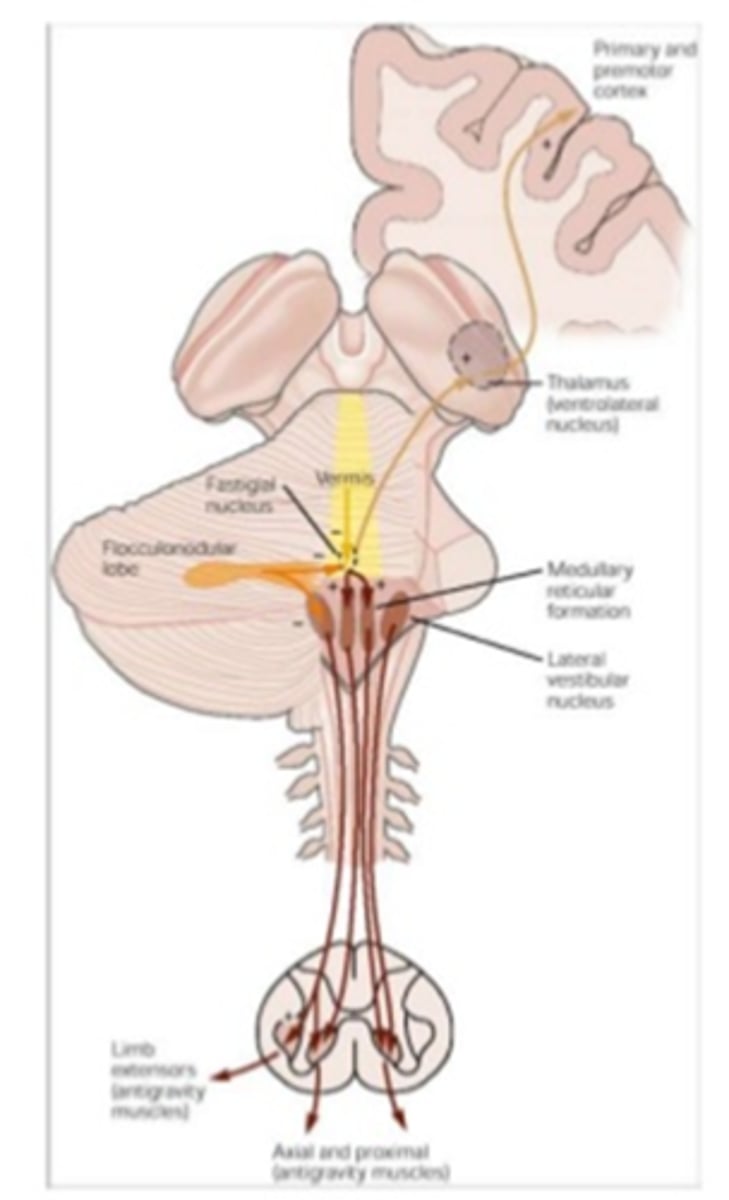
tractus olivospinalis
substantia alba, tractus descendentes
formed by: axons of nuclei olivares
descends to: motor nuclei cornu anterioris (spinal cord)
function: balance pathway
- coordination of movements concerning balance + posture
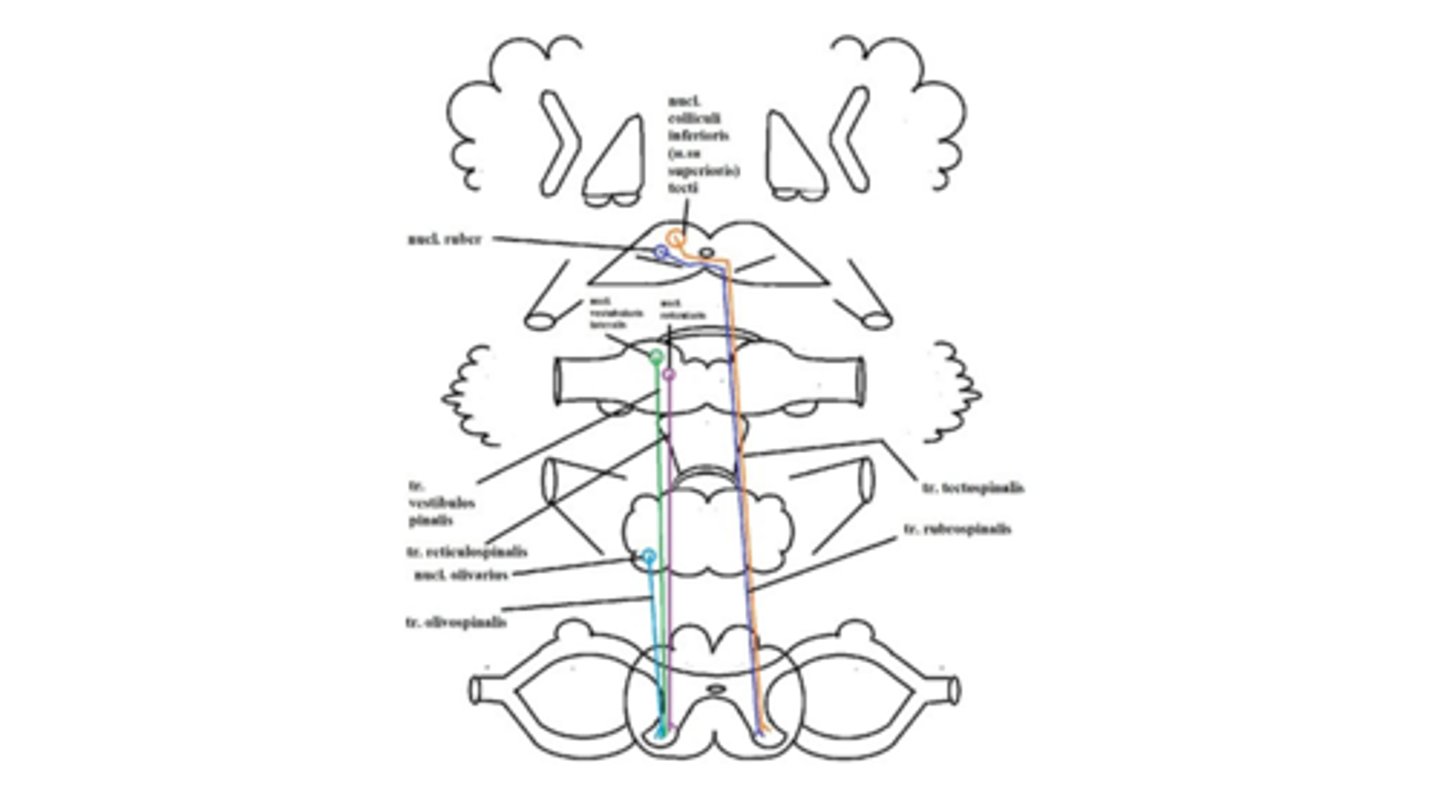
tractus olivocerebellaris
substantia alba, tractus descendentes
formed by: axon of nuclei olivares
descends to: cortex cerebelli
- via pedunculus cerebellaris inferior
function: takes part in balance regulation
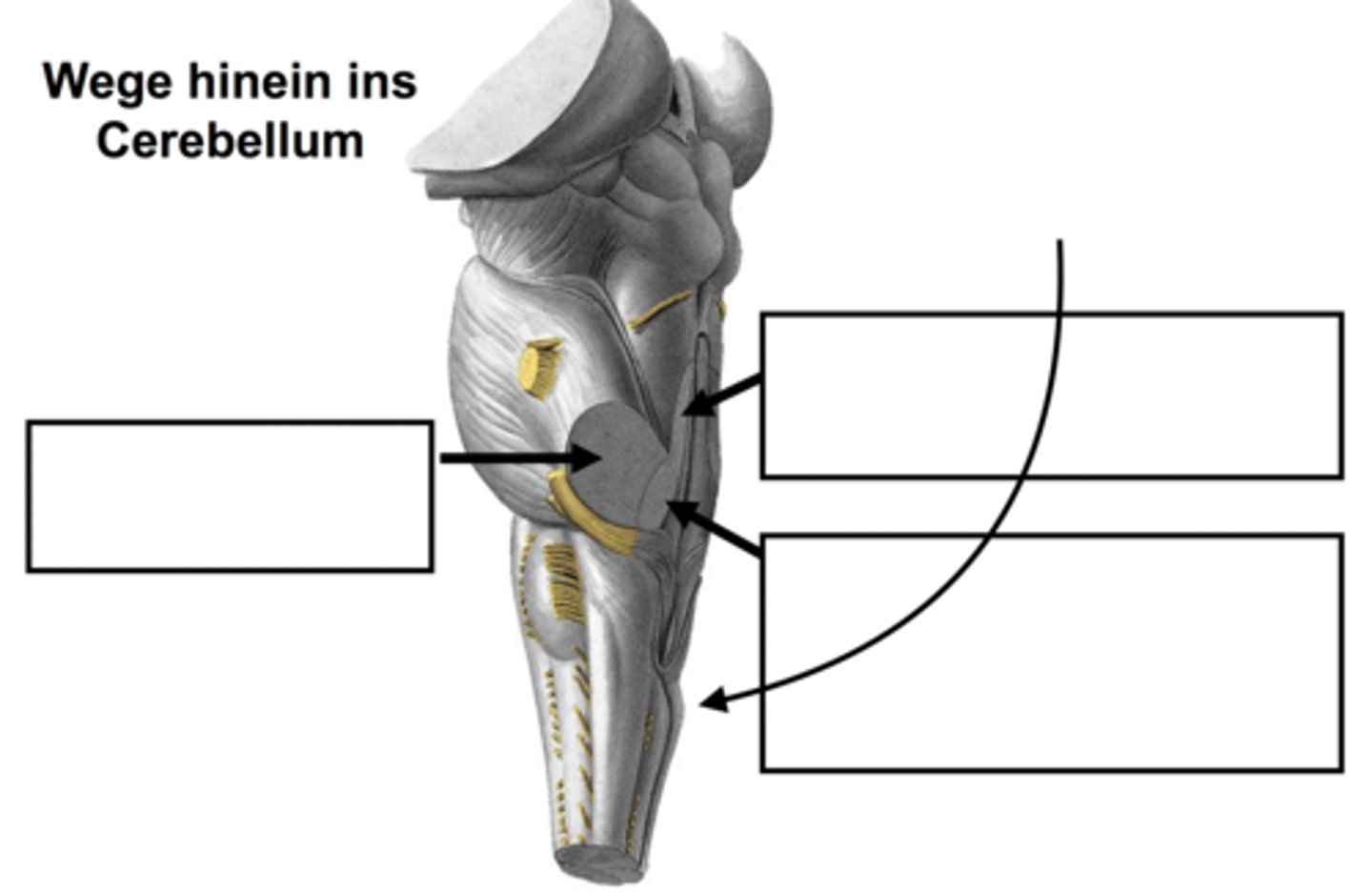
tractus vestibulospinalis, tractus reticulospinalis - picture
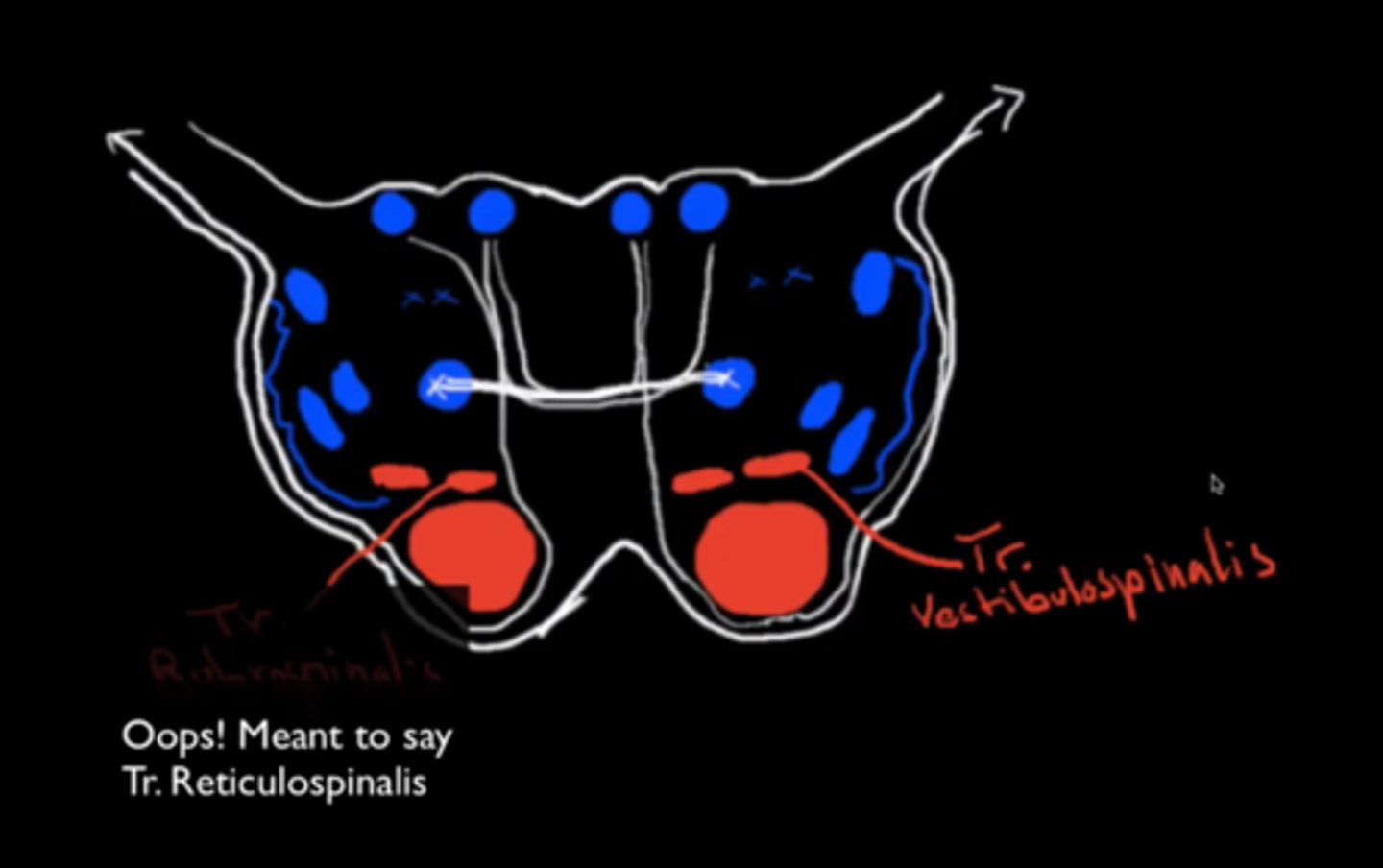
fasciculus longitudinalis medialis, tractus tectospinalis, tractus rubrospinalis - pictures
